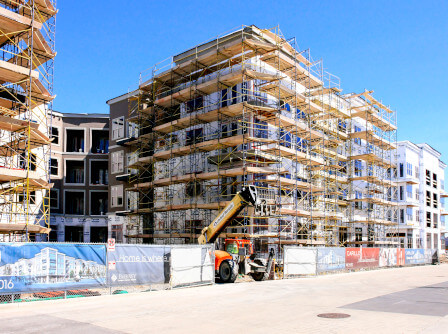With the cost of construction materials calming down, there are encouraging signs for developers to start looking into new projects again. However, with some significant changes in residential property development over the past few years, John O'Leary, Relationship Director at Secure Trust Bank Real Estate Finance, looks at the current industry landscape and identifies three trends set to shape the sector over the next 12 months and beyond.
It's fair to say that the residential property development industry has been in turmoil since the pandemic hit. Challenging market conditions in the construction industry, coupled with high inflation and high interest rates, have dented developers' confidence in looking at new projects. Meanwhile, a cost-of-living crisis that's squeezed incomes, plus rising mortgage rates, have altered the prospects of home ownership for many.
That said, there is some light at the end of the tunnel. Rising material costs, one of the biggest issues that has been causing headaches across construction, has started to slow and, in some cases, even fall. A report by Homebuilding & Renovating found that the average annual building materials prices for 2021 were 63% higher than in 2015, but this fell in 2022 to 54.4% as availability of products like particle board and planed wood started to grow.
So, with a myriad of factors at play, some lingering uncertainty, and fast-moving market conditions, what should residential property developers be considering when looking at business plans and securing residential development finance? It may not be as complex as it seems, but there are certainly three key trends to note going forward.
1. Build to rent instead of build to sell
 Given the steep rise in mortgage rates, plus the shortage of housing and soaring house prices, first-time buyers are feeling further away from getting on the property ladder than ever before. For many, the aspiration to own their own home may even sadly feel like a dream that will never be realised.
Given the steep rise in mortgage rates, plus the shortage of housing and soaring house prices, first-time buyers are feeling further away from getting on the property ladder than ever before. For many, the aspiration to own their own home may even sadly feel like a dream that will never be realised.
This has fuelled an emerging subsector of the residential property development market, Build to Rent (BTR). According to BNP Paribas Real Estate, investment in UK BTR exceeded £1.1bn in Q1 2023.
These properties are purpose-built specifically for the rental market and differ to traditional residential buildings in a few ways. Often sited in highly urbanised areas, they are designed to suit a renter's lifestyle. Rather than simply being a block of apartments though, BTR properties often come with communal areas and services like a concierge, gyms, outdoor spaces, and dining areas, all to encourage a sense of community that you might expect from an estate in the suburbs.
For developers, this could well be the property development model that usurps the traditional method of building properties to sell, given how market forces mean low margins from high build costs. However, there are different skills needed to fulfil this vision. Developing a build to rent scheme means you will effectively become a landlord that has to manage tenants, maintenance, renewals, insurance and more. In the long term though, by holding on to strategic assets, this could prove a fruitful venture for property developers and investors.
2. Potential EPC changes incoming
 Another area that residential property developers and landlords must be aware of is the widely anticipated changes to EPCs (Energy Performance Certificates). In a nutshell, at some point between 2025-2028, it is likely that legislation will come in that means all properties will need an EPC C rating or higher to be able to be let out to tenants.
Another area that residential property developers and landlords must be aware of is the widely anticipated changes to EPCs (Energy Performance Certificates). In a nutshell, at some point between 2025-2028, it is likely that legislation will come in that means all properties will need an EPC C rating or higher to be able to be let out to tenants.
Currently, properties need only an EPC rating of E or above to be let out. This will change slightly from 2025, as all newly rented properties will need an EPC C rating, but existing tenancies are not affected by this regulation and they can continue to be let out with EPC E ratings. Not only will these changes be good for the planet, but they will also benefit renters' energy bills, which is of particular interest given a recent BBC Investigation's findings that six out of ten renters were living in inefficient homes.
What this means is that any developers looking to invest in a legacy building will need to allocate more funding towards improving the energy efficiency of the property, or units within the property before it is deemed suitable for rental.
For this reason, Secure Trust Bank Real Estate Finance offers a specific EPC Improvement Loan for residential landlords. Available to existing customers, the facility is designed to help landlords obtain funding to remediate their property portfolios with energy saving solutions. The new product is an extension (top-up) to an existing loan, providing fixed sums of £6,500 and £13,000 for EPC D and EPC E rated assets respectively.
3. Budgeting for sustainable drainage
In the same vein as securing additional loans to improve the energy efficiency of legacy buildings, residential property developers should also think about the finance that will be required for sustainable drainage systems (SuDS) across their schemes.
Driving this is the new rule coming into force across England from 2024 onward, which is the implementation of 'Schedule 3' from the Flood and Water Management Act 2010. In essence, this makes SuDS a necessary obligation, with the aim of helping to further reduce surface water flooding and water pollution while also lowering the pressure on sewerage systems that often get overwhelmed in heavy rainfall events.
SuDS are expected to be compulsory for any new development, building or structure over 100sqm, as well as for retrofit schemes. Developers will be expected to show their SuDS plans to SuDS Approving Bodies (SABs), who are part of the local authority and have the power to approve (or not approve) drainage applications, and by extension, planning applications. As such, budgeting for these systems will be a necessity, and should not be forgotten when planning new buildings funded by property development loans.
A positive outlook
While there are certainly still many trials to overcome, it could be argued that we're getting over what has been one of the most difficult periods in residential property development history. Developers and investors can take heart from the easing conditions but should keep one eye on their property portfolios and changes in legislation to stay ahead.
At Secure Trust Bank, one of our main pillars to our business is care - and we extend this out to our customers. Hence, whether it's residential development finance, build to rent finance for a new BTR scheme, a refinancing deal, or an EPC Improvement Loan, we can help find the right facility under the right terms to help you fulfil your project's goals.
For anyone seeking advice or looking to secure build to rent finance, Secure Trust Bank Real Estate Finance offers loans between £2m and £45m, and are on hand to provide advice and guidance in this area.
To find out more, please visit Secure Trust Bank Real Estate Finance.

